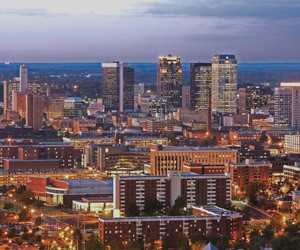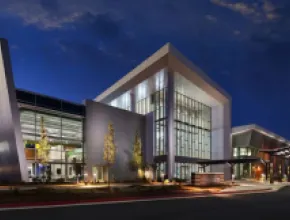The Magic City has been learning some new tricks. With a new entertainment district in the works, unexpected troves of group-friendly green space and a bright future as a sports destination, Birmingham has more up its sleeve than many planners realize.
The Birmingham Entertainment District, which will be anchored by the Birmingham Jefferson Convention Complex (BJCC), is scheduled for completion in early 2013. It will offer 60,000 square feet of new entertainment venues, retail shops and restaurants, as well as a new meetings hotel, the 294-room Westin, which will connect to the existing 770-room Sheraton. The area is already home to Birmingham Museum of Art and the Alabama Sports Hall of Fame.
The city’s crown meetings jewel, the BJCC, boasts more than 220,000 square feet of exhibition space, 74 meeting rooms, a 2,800-seat concert venue, a 1,000-person theater and two 2,000-person ballrooms as well as a specially designed conference center with a wet lab for medical summits.
Larger meetings hotels downtown include the Sheraton Birmingham Hotel, Doubletree Hotel Birmingham and Wynfrey Hotel, soon to be the Hyatt Regency Birmingham.
Hyatt Place Birmingham Downtown, the historic Tutwiler and the venerable Redmont Hotel are among the smaller properties.
Outside downtown, Greater Birmingham offers a wide variety of meetings properties, including the Holiday Inn Birmingham-Airport, Renaissance Ross Bridge Golf Resort & Spa in Hoover, Hilton Birmingham Perimeter Park and Birmingham Marriott.
With Birmingham International Airport just 10 minutes from downtown, Birmingham’s accessibility is one of its biggest selling points.
“What gives Birmingham an edge is the Southern charm of our city and the accessibility, with an international airport, three major interstates and two major highways coming right into the city, making driving a snap from most parts of the country,” says Mike Gunn, vice president of sales at the Greater Birmingham CVB.
Up and Coming
Apart from its fantastic location, ease of travel and stellar meeting venues, Birmingham is emerging as a choice spot for athletic events.
“Most frequently Birmingham receives positive feedback from our customers regarding ease of maneuvering in and out of the city,” Gunn says. “The friendliness of the staff, the team work and the flexibility of hotels and meeting space are also mentioned. As a meetings destination, I see Birmingham becoming a major player in the sports arena, as well as a preferred meeting destination.”
The city certainly has plenty to offer sports event planners as well as sports fans. Its athletic venues include the 17,000-seat BJCC Arena, the 8,500-seat Bartow Arena on the campus of the University of Alabama at Birmingham (UAB), the 6,000-seat Fair Park Arena and the 5,000-seat Boutwell Auditorium. Legion Field is a football and soccer stadium that seats more than 71,000, and Pelham Civic Center houses two NHL-sized skating rinks and 5,000 seats. Rickwood Field, one of the country’s oldest baseball fields and a member of the National Register of Historic Places, still hosts games and is also being prepared as the site for a baseball museum.
Meanwhile, fishing enthusiasts tout Birmingham waters for record-breaking bass; NASCAR fans can make pilgrimages to Barber Motorsports Park, Barber Vintage Motorsports Museum and Talladega Super Speedway; and golfers will be delighted to explore the Robert Trent Jones Golf Trail. While visiting Birmingham, sporting groups can also enjoy a visit to the Alabama Sports Hall of Fame.
Past and Present
A number of fascinating museums give groups a chance to explore different facets of Birmingham’s rich history.
As the site of infamous church bombings and momentous demonstrations, as well as the home of impassioned leaders, Birmingham was ground zero for the 1960s civil rights movement. Birmingham Civil Rights Institute was created to promote education about civil and human rights worldwide. The institute can host events as large as 300 in its handsome rotunda or welcome smaller groups in meeting and lecture rooms.
Vulcan Park and Museum pays homage to the rich lode of iron ore that inspired Birmingham’s founding and to the strong metalworking traditions of the city. At 56 feet high and 101,200 pounds, the statue of Vulcan, Roman god of the forge, is the world’s largest cast iron statue. It overlooks the city and the museum, which showcases the history of the region, its iron, and the statue itself. The park and museum can accommodate groups of up to 350.
For 90 years, Sloss Furnaces produced the iron bones of Birmingham and other U.S. cities. Today, the smokestacks and blast furnaces of Sloss Furnaces National Historic Landmark are preserved to commemorate the city’s relationship with iron and the important subjects of labor and race in industrial America. It is the only 20th century blast furnace in the country preserved as a museum. Groups as large as 2,500 can gather for events at the facility.
Out and About
For planners who think of Birmingham solely as urban and industrial, prepare yourselves for vast green oases of natural beauty. Given the city’s balmy clime, groups shouldn’t miss the opportunity to take advantage of the abundant outdoor venues.
The city is home to two extensive mountain parks perfect for group adventures and off-site events.
For generations, Red Mountain was mined for the iron that gave it its distinctive color. Soon, Red Mountain Park will be open to the public as a new regional attraction and one of the largest urban parks in the U.S. The park will consist of 1,200 acres, where groups can visit historic mines and take an exciting zip line tour. New in spring 2012, the Red Ore Zip Tour will offer 10 treetop platforms connected by zip lines running from 100 to 350 feet long down the side of the mountain.
Ruffner Mountain Nature Center comprises 1,000 acres of Birmingham’s undeveloped Red Mountain ridge. Just 10 minutes from downtown, the preserve has miles of forested trail, wetlands, historic mining sites and a large population of wildlife. The LEED Gold-certified center is home to the Tree Top Activity Hall, which can welcome groups of up to 100 for receptions. The Mountainside Pavilion can host events as large as 150.
Completed in 2010, Railroad Park presents 19 acres of urban green space and water that also memorializes the city’s proud past as an industrial powerhouse. There are many covered and outdoor spaces to choose from, and groups of up to several thousand can be accommodated. The park stretches from downtown to Southside and to the UAB campus, and is affectionately called “Birmingham’s living room.”
Sibyl Temple was designed by a former mayor of Birmingham as a replica of an ancient Roman temple he saw in Tivoli, Italy. A member of the Alabama Register of Landmarks, the Grecian-style gazebo tops Shades Mountain in nearby Vestavia Hills and can welcome approximately 150 for outdoor events.
Kelly Crumrin is a freelance writer and frequent contributor to Meetings Focus South. She would remind anyone planning a trip to the South that “grits” is a singular noun, as in “The grits in Birmingham is the best in the world.”






